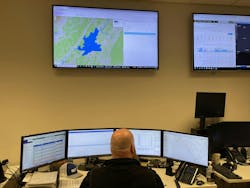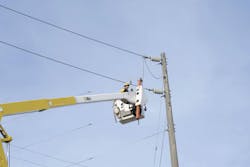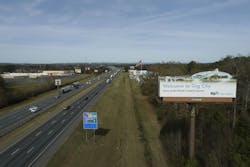With Better Communications, Chattanooga Reinvents Itself
In the early 1980s, Chattanooga, Tennessee, U.S., found itself at a crossroads. Once a thriving manufacturing town, the mid-sized city was grappling with economic uncertainty as businesses closed or offshored operations. The city’s downtown was still home to several major employers, but it became a ghost town after 5 p.m. when workers headed home. And, although the city sits on the Tennessee River, it had become cut off from its river roots.
Rather than allowing the community to slip into decline, Chattanoogans came together on a public visioning process that culminated with a commitment to making Chattanooga the best mid-sized city in America. They embraced a portfolio of projects, including the establishment of the Tennessee Aquarium on Chattanooga’s downtown riverfront. Although the earliest projects were focused on redevelopment, community leaders and organizations took up the vision as a question in addressing a range of issues.
Over the next three decades, a wave of revitalization projects took off across the community. In the early 2000s, the city’s municipal electric utility, EPB of Chattanooga, engaged Hexagon AB, a global technology company, to launch a project that has become key to Chattanooga’s continuing transformation. With their technology along with several other solutions, EPB built an advanced, fiber-optic-based smart grid and offered 1-GB-per-second internet service to every home and business in its 600-sq-mile (1554-sq-km) service territory. The project was part of Chattanooga’s goal of becoming “Gig City” by reinventing itself through innovation and technology.
The city is now launching 25-GB community-wide internet service and establishing a commercially available quantum network, EPB Quantum Network, powered by Qubitekk Inc.
From Vision to Reality
In the late 1990s, EPB began exploring the possibility of enhancing the resilience and reliability of Chattanooga’s electric grid by deploying automated switches and other connected devices across the local system. Unfortunately, the communications technologies typically used in the electric industry at that time were only adequate for smaller-scale projects and tended to become obsolete quickly. EPB’s plan called for deploying well over 1,000 automated switches across 600 sq miles. The solution? A smart grid built on a fiber-optic network, capable of delivering more reliable electricity and high-speed fiber-optic internet services to every corner of its service area.
EPB launched its ambitious construction project in 2009, as the U.S. headed into the Great Recession. The original plan was to complete 90% of the network over 10 years. However, with the help of a US $111.5 million grant from the Department of Energy, EPB was able to accelerate its timeline, finishing the fiber deployment to make the network accessible to all customers after just two years. Once online, the fiber-optic network that underlaid the electrical system served as the communications backbone for the most advanced and highly automated smart grid in the U.S., while also providing EPB with the connectivity necessary to launch the world’s fastest community-wide internet.
The fiber network was not just built for the city’s needs at the time; it was future-proofed from the start. Once the fiber-optic network was in place, EPB layered in the additional components necessary to complete the smart grid, including advanced meters and automated IntelliRupter switches from S&C Electric Co., which reduced power outage times and made the system more resilient. EPB’s approach ensured all areas — urban, suburban and rural — were included in this technological leap forward, demonstrating its commitment to serving the entire community.
Powering Innovation
Geospatial asset management software that made it possible for EPB to integrate its electric grid with its new fiber network. This hybrid model, which enabled EPB to co-locate fiber infrastructure within existing electricity infrastructure, minimized construction costs and streamlined the entire deployment.
The Hexagon technology was able to support both immediate and long-term needs, allowing EPB to upgrade network electronics, such as optical network terminals, without needing to overhaul the entire fiber infrastructure. This flexibility meant EPB could continually enhance internet speeds — from 1 GB in 2010, to 10 GB in 2015, to 25 GB in 2022 — all while keeping costs manageable.
Proprietary integration tools also made it easier for EPB to monitor and manage the grid, ensuring both power and fiber infrastructure were optimized for maximum efficiency. This approach not only supported the smart grid’s immediate needs but also prepared the system for future upgrades and expansions.
Overcoming Obstacles
Building Chattanooga’s smart grid was no small feat. EPB faced technical and operational challenges in bringing the project to life. One of the biggest obstacles was ensuring the system would support not only the initial construction but also long-term operations. EPB needed to develop new systems and adapt existing ones to ensure its ambitious infrastructure plans could be sustained.
Another challenge involved navigating the complexities of deploying fiber and smart grid technology across a diverse geographic area. EPB’s service territory includes urban centers, suburban developments and remote rural communities, each with its own demands. As part of EPB’s mission to enhance quality of life for the whole community, ensuring rural areas could access the network was always a nonnegotiable part of the plan. Thanks to its model of using the fiber-optic connectivity to deliver both internet services and support smart grid communications, EPB’s deployment has proven to be successful even though margins are lower in areas where customers are more distant from each other.
EPB’s smart grid project was able to help close the digital divide. The symmetrical high-speed network provides the same speeds to urban and rural communities, ensuring even the most remote areas of its 600-sq-mile service area have access to the same high-speed internet as its urban core. These same capabilities extended the benefits of broadband to economically disadvantaged families through HCS EdConnect, powered by EPB, which supplies high-speed home internet at no charge to Hamilton County Schools students who qualify for free and reduced lunch. Started as a pandemic-era program to connect students for home-based learning, HCS EdConnect continues today, serving more than 16,000 students, who with their families represent nearly 28,000 Chattanooga area residents.
Pushing Boundaries
The smart grid and fast reliable internet access brought economic and social benefits to Chattanooga. In the first decade of operation, the grid generated $2.7 billion in community value, according to a study conducted by The University of Tennessee in Chattanooga. That value included the creation of nearly 10,000 jobs and a 55% reduction in power outages. By reducing outage minutes by more than one-half, EPB saves its customers $55 million annually, helping them avoid food spoilage, lost productivity and other negative impacts.
In addition, Chattanooga’s fiber network has attracted tech companies and high-paying jobs, making the city a hub for innovation. EPB’s role in bringing innovative infrastructure to the city even earned it recognition as a “living laboratory” and more than $110 million in Smart City research by the U.S. Department of Energy.
EPB’s commitment to innovation did not end with the deployment of the smart grid. Over the past decade, the utility has continued to push the boundaries of what is possible. In 2022, it became the first provider in the nation to offer community-wide 25-GB internet service. This was possible because EPB had undertaken a five-year, $70 million upgrade to the system, which included increasing the core capacity of its fiber network to 100 GB.
In addition to boosting internet speeds, EPB also is exploring new ways to enhance grid resilience. The utility has launched several energy storage facilities and microgrid installations at critical facilities like the Chattanooga airport as well as the Chattanooga Police Services Center and Fire Department administrative headquarters. These microgrids allow EPB to island portions of the grid during outages, ensuring power remains available even when the main grid is offline. It also is investing in energy storage in more rural parts of its grid that can only be served by a single line to ensure those customers also experience fewer outages and increased reliability.
In addition, EPB collaborates with a range of national and local research partners. In fact, its partnership with Oak Ridge National Laboratory has only further cemented Chattanooga’s reputation as a hub for advanced research as the pair works together on emerging technologies and applications, including quantum technology networks and deploying drones to identify issues in hard-to-access locations of the grid.
Lessons Learned
EPB’s success in Chattanooga offers valuable insights for other utilities and telecommunications providers looking to modernize. One of the key lessons is the importance of pairing energy and connectivity services. By integrating the smart grid with fiber-optic broadband, EPB realized operational savings and created a more resilient system that better serves its customers.
Another lesson is the value of strategic partnerships. Hexagon’s utility geospatial asset management technology allowed EPB to optimize the deployment of both fiber and electric infrastructure, reducing costs and improving efficiency. This partnership enabled EPB to offer the fastest community-wide internet speeds in the country while also maintaining a world-class power grid.
Finally, EPB’s approach to grants and funding also provides a model. Rather than relying on federal and state grants to drive its strategy, EPB develops a long-term plan and then seeks grants to accelerate projects already in the works. This ensures projects are both financially sustainable and aligned with its broader, community-focused mission.
The partnership between EPB and Hexagon has transformed Chattanooga into a national leader in smart grid technology and high-speed internet access. By building a fiber network to serve multiple use cases, EPB has improved reliability and reduced outages while helping more people benefit from broadband access. For other electric utilities and telecommunications companies, EPB’s experience offers a road map for success through strategic planning, innovative technology partnerships and a commitment to serving the entire community.
As cities and towns across the U.S. look to modernize infrastructure, EPB’s smart grid serves as a beacon of what is possible — a model where energy and connectivity converge to create sustainable, resilient communities. Utilities and telecommunications providers can find inspiration in Chattanooga’s journey, learning that with vision, collaboration and the right technology, they too can power their communities toward a smarter, more connected future.
About the Author
Don Lorente
Don Lorente is technical director at Hexagon’s safety, infrastructure and geospatial division. Don has more than 35 years’ experience in the telecommunications, gas and electric industries. He has been with Hexagon for 30 of these 35 years. During his tenure, he has architected and led the implementation of networks systems for utilities and telecommunications customers across Canada, as well as consulted on a North American level.
J. Ed. Marston
J. Ed. Marston leads EPB’s Strategic Communication efforts which include public relations, community engagement and corporate communications. Since joining EPB in 2014, he has played a key role in promoting EPB and Chattanooga with a particular focus on community benefit, economic development and sustainability. Prior to joining EPB, he served as Vice President of Marketing and Communications at the Chattanooga Area Chamber of Commerce for twelve years. Marston holds a Bachelor of Arts in English and Writing from Spring Hill College in Mobile. He is also a graduate of the U.S. Chamber’s Institute of Organizational Management.




